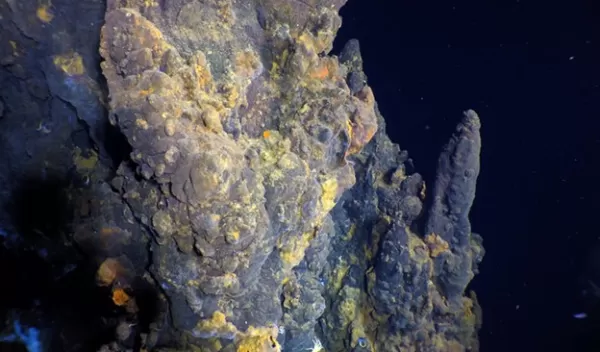
First known off-axis, high-temperature deep sea hydrothermal vents along portion of the northern East Pacific Rise
Finding a new, high-temperature, off-axis hydrothermal vent field on the floor of the Pacific Ocean at 2,550 meters (8,366 feet) down could change scientists' understanding of the impact such seafloor vent systems have on ocean life and chemistry.
U.S. National Science Foundation-supported researchers including Jill McDermott, a chemical oceanographer at Lehigh University, have discovered just such an off-axis hydrothermal field. It’s named YBW-Sentry and is near the global mid-ocean ridge known as the East Pacific Rise.
The study area is about 200 miles off the west coast of Mexico. The new vent site covers an area equivalent to a football field, roughly twice the size of the nearest active hydrothermal vents in the region. The vent chimneys look like candelabras and are the height of three-story buildings. The findings are published in Proceedings of the National Academy of Sciences.
Deep-sea hydrothermal vents are found around the world, most often in volcanically active locations along the crest of the global mid-ocean ridge system. Magmatic activity, driven by upwellings of heat in Earth's mantle, causes the brittle tectonic plates that make up Earth's outer shell, or crust, to split.
As the plates spread, new seafloor rock is formed by magmatic activity and volcanic eruptions. That magmatic and tectonic activity creates cracks through which seawater percolates in crustal rocks. Much like hot springs on land, hydrothermal vents spout mineral-rich liquid that has been heated beneath the seafloor.
Dan Fornari, a marine geologist at the Woods Hole Oceanographic Institution and a co-author of the paper, said, "We were astounded that not only is this field very active, but is larger and hotter than any other hydrothermal vent field known along this portion of the East Pacific Rise."
Near-bottom bathymetric surveys conducted with the autonomous underwater vehicle Sentry produced high-resolution maps that resolve the vent field’s small seafloor features, according to Ross Parnell-Turner, a geophysicist at the Scripps Institution of Oceanography and a co-author of the paper.
"This study shows the bathymetric detail that’s provided by AUV Sentry and its high-resolution camera system," said Kevin Johnson, a program director in NSF's Division of Ocean Sciences. “Sentry enables observations and seafloor sampling at unprecedented range and precision.”


